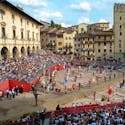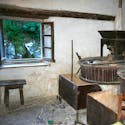Discover the Art of Piero della Francesca
Whether you have or haven’t heard about the artist Piero della Francesca (1416? – 1492), his works left a profound mark on the Renaissance era that you cannot have easily missed. His mathematical genius gave birth to a new style of painting, a style which would begin to put things into perspective quite literally.
We have created an itinerary which incorporates some of his most noted pieces of art, a few gorgeous small Tuscan towns, and a day wandering through the landscape of Arezzo - an area frequently ignored by tourists. The itinerary below highlights where you can find the artworks, a brief summary of what you are looking at and a few ideas of what is nearby.
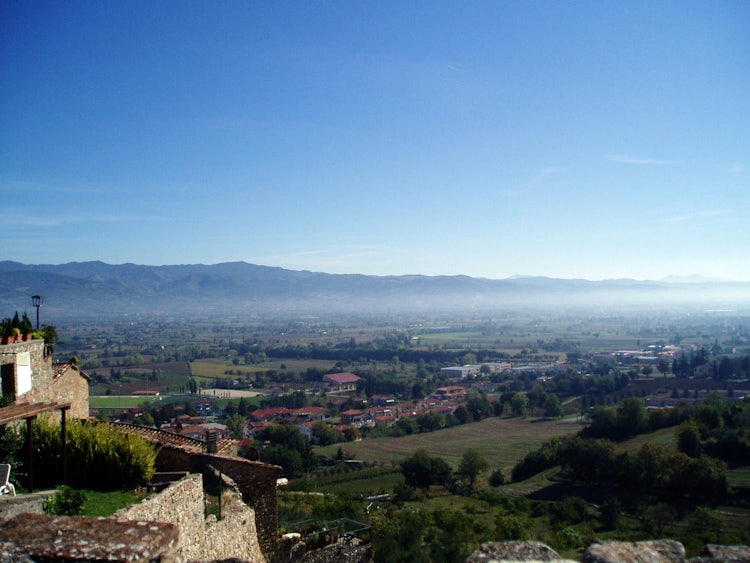
The Man Behind the Paintings
The small, yet thriving, town of Borgo San Sepolcro (known as Sansepolcro today) gave birth to this amazing artist. From this position on the map, in the farthest eastern corner of Tuscany, he traveled between his hometown, Arezzo, Florence, Rome and the east coast of Italy working on commission for churches and private individuals.
However, even with all this travelling, the major concentration of his work hangs in the province of Arezzo.
Many can name several Renaissance artists in this period: Michelangelo, Botticelli, Donatello, to mention a few. And after a fairly recent re-discovery in the last few decades, Piero della Francesca has earned a place in the roll call of famous artists.
In the 1400’s, he was known as a mathematician and geometer writing thesis and documents exploring calculations concerning volume and shape as well as elaborating equations in math useful for adding up taxes.

It is only today that we have begun to appreciate his immense contribution to art and the painted image; with his unique background in numbers, he gave a touch of reality to his works, shying away from the popular gold backgrounds to add landscapes and architectural forms which would give perspective and add depth to his images.
His spacious, monumental and impossibly rational painting is undoubtedly one of the highest achievements of the artistic ideals of the early Renaissance, an age in which art and science were bound together very deeply.
In particular, Piero della Francesca's masterpieces are spread out between Arezzo, Monterchi, and Sansepolcro in the province of Arezzo. As an early Italian Renaissance painter, Piero della Francesca’s paintings were “characterized by a serene humanism, geometric forms and use of perspective” using color and spatial relations to give life to a new form of “storytelling”.

An Itinerary: Art, Landscapes & Small Towns
This itinerary starts in Arezzo and takes you east to Sansepolcro (see map below for alternative routes), touching on the highlights of Piero della Francesca's works and the area. Each one of the towns mentioned offers much more than what we talk about in this article, but this itinerary is concentrated on exploring places and things that are directly connected to Piero. But you can definitely add to your travels by also exploring the towns.
This area around Arezzo is known as the “Terre di Piero” (the land of Piero) and the works that you will see are rather tied to their location because they are frescoes - even though several have been moved from their original location. At one point, his work in Sansepolcro was requested for an exhibition and the town decided that if you wanted to see his work, you needed to come to them, as Piero doesn’t move.
1. Arezzo and his Grand Masterpiece
Basilica of St. Francis
Via di San Francesco - Arezzo
Opening Times & Prices: check the official website
The church visit should take approximately 1 - 1.5 hours.
Important Note: Reserve a time to get up close
One of the largest and most recognized masterpieces by Piero della Francesca is beautifully preserved in its original setting, in the main choir chapel (Cappella Maggiore) of San Francesco, the Franciscan church in Arezzo.
The height of the walls makes it difficult to appreciate the story from top to bottom, though a pair of binoculars or opera glasses would help you bring the details into focus.

What makes this piece so special?
People have written books and thesis on the details within this series of frescoes which tells the “Legend of the True Cross” (see the story in the right column). The works in the church are well documented in both English and Italian and you can purchase a well-written guidebook that will walk you through the story behind the altar. However, if you are going to visit, a few things you might like to pick out on your own while examining the images from below would be:
- the clothing and jewelry which are rather detailed and sometimes even exotic, suggest that Piero was rather worldly having met with people from all over
- the night scene on the back wall, bottom right-hand corner (Dream of Constantine) brilliantly uses the angel as a source of light in a scene which would otherwise be completely in the shadows
- the facial expressions which show very strong emotion, especially in the battle and in the burial of Adam
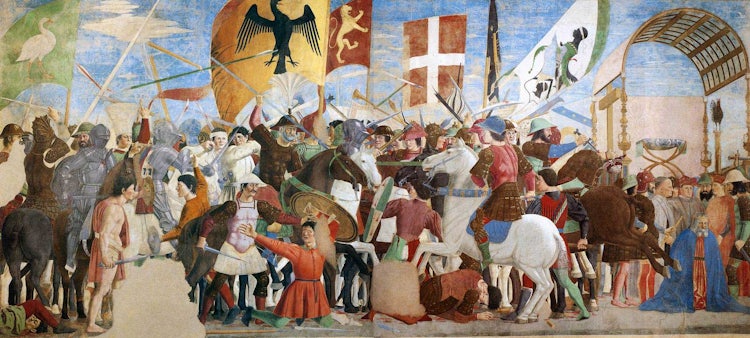
Our Suggestion
Park your car at the Pietri parking lot, stop at the Duomo of Arezzo before heading over to the Basilica of St. Francis. Take a quick tour of the interior of the Duomo to search out the almost complete fragment of Santa Maria Maddalena by Piero della Francesca, located to the left of the main altar.
Helpful Hints
Reservations are highly recommended - and are actually requested by the church upon arrival.
Your ticket gives you entrance to the church and the small area behind the altar. There is a limit to how many persons can go behind the altar at any one time, and when there are crowds, there is also a time limit of 30 minutes per group. For this reason, it is highly recommended to reserve your entrance into the apse to view the frescoes at a time that is convenient for you.
I would suggest you visit early so you have time to do the entire itinerary on this page but also because the earlier you are, the more tranquility you will have to observe his work.
2. Monterchi, a small gem to be savored
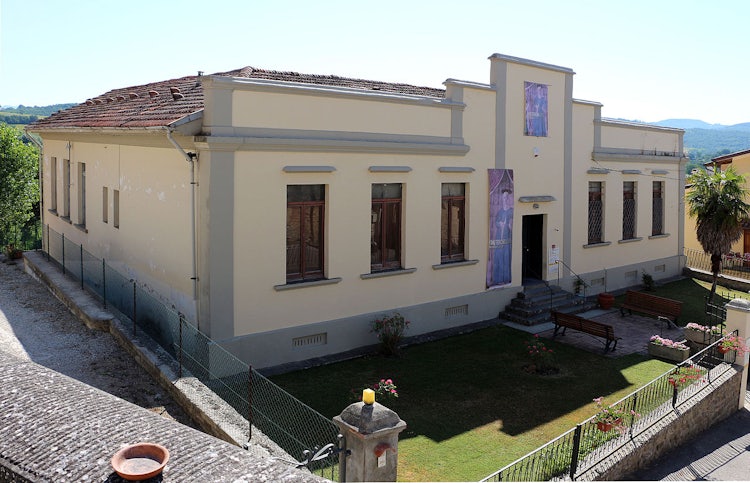
You could, of course, make a day of it in Arezzo as there is much to see, but if you are following our itinerary, you will then want to head over to a small little town called Monterchi, where you will find one of his “dolce” (sweeter) works, the Madonna del Parto, a portrait of the pregnant Virgin Mother.
Museo della Madonna del Parto & Museo delle Bilance
Opening Times & Prices: check the official website
A visit to both of these museums will take approximately 1 hour
Important Note: On March 8th of every year, in honor of International Women's Day, all women have free entrance.
As of February of 2018, the recently restored fresco “Madonna del Parto” inaugurated its new home, a spacious and luminous building situated just outside the city walls with fabulous views of Monterchi and the Valtiberina landscape.
The serenity of the woman gazing out from underneath the tent is mesmerizing, and it is easy to just sit in the shrouded room and soak in the tranquility that emanates from the image. There is a short and intriguing film that has English subtitles which will give some insight to the incredible work that went behind creating the perspective in this small painting.
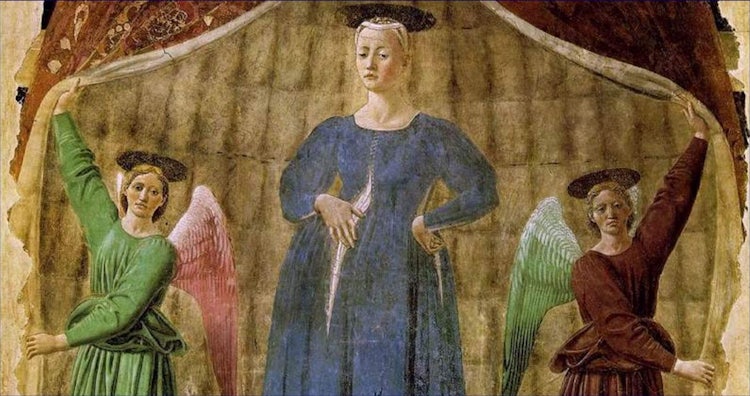
What makes this piece so special?
Without a doubt, what is most striking about his work is the incredible mathematical mind behind the precision of the perspective created by the use of geometrical equations and the number of symbols from the motif on the tent to the inverted colors on the angels. You may have thought it was the fact that the Blessed Mother is depicted while pregnant, but actually, this was a rather common theme.
Our Suggestion
The new location of the Madonna del Parto, situated outside the city walls of Monterchi, invites you to take some lovely photos of the scenery in the Valtiberina, the valley where the Tiber river passes through before reaching Rome. With a short walk of less than a 100 meters, you can enter the city through one of the existing antique gates, and visit a small museum dedicated to scales, weights, and balances.
One of the little-known facts made evident at the museum is that this area, especially the river next to the church where the fresco was once located, was well known for its miraculous fertile capabilities. The image is comprised of the Madonna, long-time champion of couples looking to become pregnant, and two angels holding back the flaps of a protective tent in red with the imprint of a fruit long known as a symbol of fertility.
Piero completed this work in a miraculous 7 days when he came home for his mother’s funeral, and it is speculated that she was the model for the Madonna, a theory which has some credit since this piece was originally hung in her hometown church.
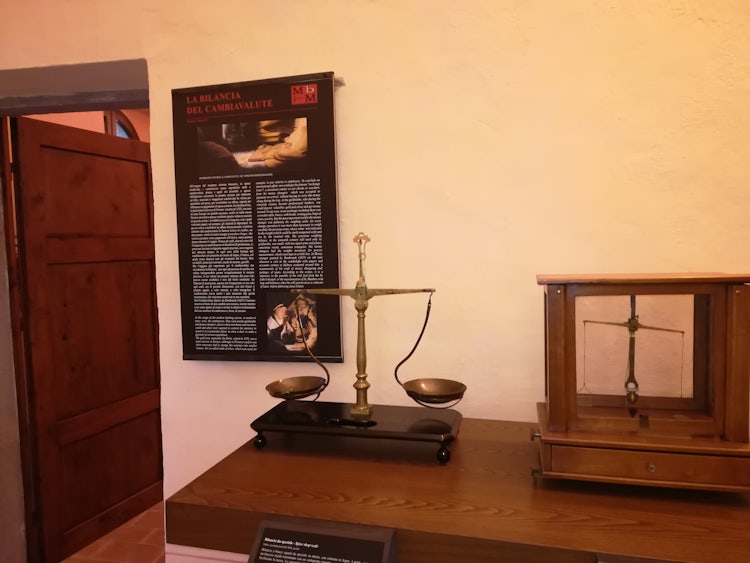
The curious collection of antique scales from Italy and all over Europe provides a peek into the very serious business of weighing out items both large and small. Since Monterchi and the surrounding towns of Sansepolcro and Anghiari were all border towns, they were charged with the responsibility of collecting taxes on the products that would cross the regional border thus a well functional scale was extremely important. Information is provided in English and Italian, and the building itself is quite interesting.
Helpful Hint
Ask for the Valtiberina PASS for a discount on admissions to museums around Valtiberina, it will look like a bookmark, and is valid until you use it up (it does not expire). There are both a gift shop and bathrooms at this location. Guests can find free parking directly in front of the museum, but be aware that this exhibition attracts many Italian tourists who will arrive with large buses. The room for the fresco is thoughtfully furnished with benches, but it can fill up rather quickly if a bus arrives.
3. Sansepolcro, Piero's hometown
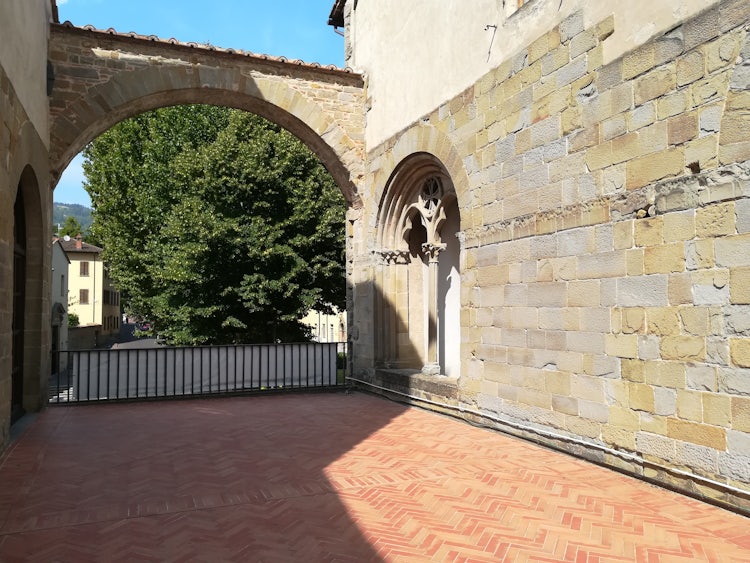
Museo Civico Sansepolcro
Opening Hours & dates: check the official website
To visit the entire museum, plan on at least 1.5 hours (unless there is a temporary exhibition, and then it could take longer), the house of Piero is much smaller and you can breeze through it in 20 - 30 minutes.
While searching out works of art by Piero della Francesca, your last stop in the province of Arezzo will be the Civic Museum in Sansepolcro, where you will find the fresco of "The Risen Christ" recently opened to the public in March 2018 after a long and detailed restoration by the Opificio delle Pietre Dure laboratory in Florence.
The powerful image of Christ walking out of the tomb as four Roman soldiers sleep before him is showcased in a lovely palazzo (the Museo Civico) just outside the city walls which has been beautifully restored.
Not only has the restoration secured the colors and health of the fresco but it has unearthed a few interesting “details”. For example, restoration confirmed that the wall where it resides today was not the original position. This fresco was, in fact, moved and there is a short informative video, with English subtitles, which shows the intricate work that went behind the repositioning of the masterpiece.

What makes this piece so special? You “can thank commanding British artillery officer and great appreciator of art, Tony Clarke, who was supposed to raze the city (of Sansepolcro during WWII), but defied orders — having read Aldous Huxley’s comment that Sansepolcro was home to the best painting in the world.”
Piero was commissioned to paint the fresco by the chief magistrates and governors of the town, who used it as a small altar where they would pray before starting any meeting. Besides the striking pose of Christ emerging from the tomb, the mathematical genius which created this composition included two vanishing points. This means that there are actually 2 vantage points from which an observer can experience the artwork.
One of the vanishing points are the eyes of Christ, which appear to have the “vision of God” because they follow you wherever you go in the room. The second is level with the left foot of Christ resting upon the Roman sarcophagus.
This just happens to be level with the soldier resting his head back on the staff of Christ, and which is rumored to be a self-portrait of the artist himself. Note the image featuring this detail at the beginning of the article.
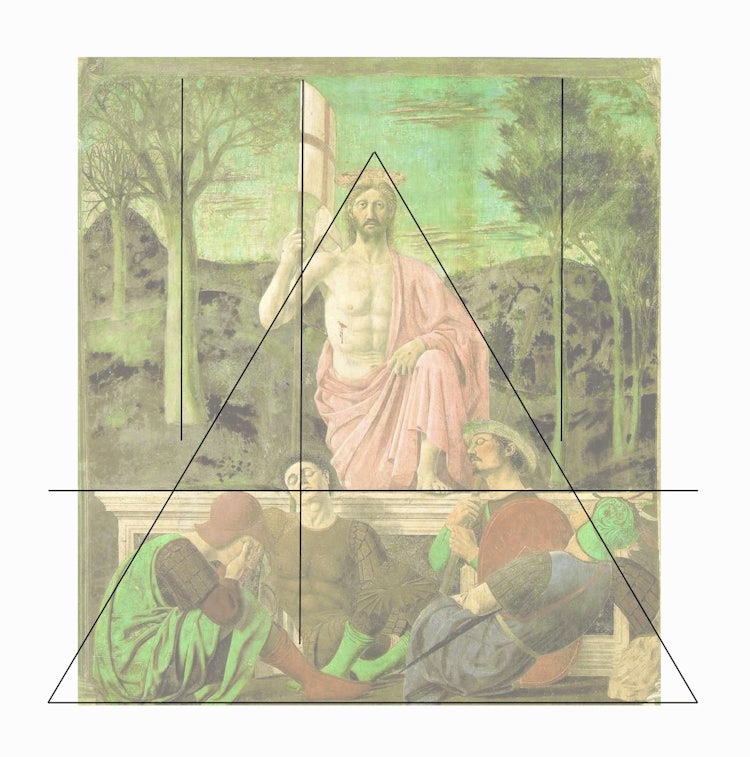
Our Suggestion
Just 50 meters away from the museum is the house that Piero della Francesca actually designed and eventually lived in. Though it has been re-managed several times, critics have proven that the first floor remains virtually intact from the artist's designs. For an extra euro to your Museo Civico ticket, you can visit Piero’s house. I found the villa to be well restored, leaving the rooms unencumbered and elegantly simple in their decor. They have made the rooms even more entertaining by setting mannequins dressed as different persons visible in Piero della Francesca’s paintings and they have a permanent exhibition of jewelry and gemstones inspired by those same items which he painted in his masterpieces.
There are two fragments attributed to Piero della Francesca, San Ludovico, dated 1460 (Saint Ludovic) and San Giuliano, dated 1460 (Saint Julian). Both capture the face of the saints and highlight Piero’s skill at giving life to his images.
Perhaps one of the earliest works (dated between 1445/50-1467 ca) by Piero is the Polyptych of the Misericordia depicting the Madonna della Misericordia (Virgin of Mercy) on a gold background. The old style of a solid gold background was specifically requested by the group who had commissioned the piece and deviates from his style of a humanistic stage for his images, however, he manages to give depth and perspective to the image by creating a realistic space under her cape.
This museum features several important pieces which have been moved from their original site or church for their safety. The rooms are large and airy, allowing for plenty of light and space to appreciate the enormous frames and paintings housed within.

Set on three floors, there is an elevator which makes it easy to view even the topmost floor. Especially gratifying is the panoramic balcony overlooking both in and outside the city walls. The museum also has a basement, which has been restored for temporary exhibits. There are both a small gift shop and bathroom in the museum.
You will find free parking in front of the museum, but be aware that it is timed (one hour) so it requires you to leave a time-card (you can also write your arrival time on a piece of paper and leave it on the dash) in your car so that the police know how long you have been there.
Obviously, it is possible to flip-flop the itinerary and start with Sansepolcro and end in Arezzo - but that doesn’t leave much time to explore the city of Sansepolcro, which though small has quite a few lovely points of interest, starting with the Duomo just within the city walls behind the museum.
Interested in more Piero?
If you are interested in exploring even more works of art by Piero you can look at these options:
The Uffizi Gallery Museum in Florence - outside of Arezzo, still in Tuscany
Considered by many to be “one of the most celebrated portraits of the Italian Renaissance”, Piero’s diptych features the Duke of Urbino, Federico da Montefeltro (1422-1482) and his wife Battista Sforza (1446-1472). Stiff and still yet rich with minute details, these two portraits intrigue the viewer and give off a wealth of information about their character and the land where they lived.

Outside of Tuscany, but still in Italy: Urbino, Perugia, Rimini
A day trip from Tuscany could include traveling out to these points of interest: Galleria Nazionale delle Marche (Urbino), Galleria Nazionale dell'Umbria, (Perugia) and Rimini, an area where Piero left several important pieces and spent much time working.




